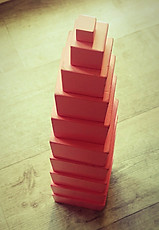Ecole Montessori Bilingue Bordeaux Rive Droite

Eclosion des Fleurs

KINDERGARTEN

Hibiscus
Lilac

Our two 3/6 classes are open to children aged 3 to 6.They are guided through activities of daily life (Practical Life), sensory education (Sensory Life), language and reading, arithmetic, geography and knowledge of the world. Artistic activities are offered to develop their creativity.

Practical life
Hands-on activities help children to become more independent and develop their concentration. This is where children develop their fine motor skills and build up their self-confidence.
Sensory life
Children are allowed to discover concepts via sensory material. Concepts such as size, weight, volume, temperature, etc. will be assimilated through the child's own experiences.


Language
Aside from French, the children will also spend time immersed in everyday English. The Montessori teaching materials help children to develop their vocabulary, learn the sounds of the alphabet and gradually learn to write and read.
Numbers
Children are introduced to the concepts of numbers in a tangible way and then gradually in a more abstract way. This enables them to get a better grasp of mathematics.Children soon move on to large numbers and additions, subtractions, multiplications and divisions.

Culture and world knowledge

Understanding the world is very important for children, in order understand interactions between people, nature, animals and the environment...
Science, geography, geology, botany, zoology enrich the children's knowledge.
Educators carefully prepare the learning environment for the children, tailored to the children's abilities. The materials designed by Maria Montessori are designed to be self-teaching, enabling the child to realise their own mistakes and freeing them from the weight of adult judgement.
Part of the materials changes over the seasons, celebrations and events... The whole is designed to foster an environment that promotes work and reinforces the child's independence and insatiable thirst for learning.
To achieve this all Montessori materials are designed to draw the eye and are easily accessible, placed on shelves at child height.
' Help me to do it myself '
Within a defined framework, children are free to progress at their own pace according to their interests and abilities. Children become responsible for their own education, can explore ideas and develop skills independently, are allowed to think for themselves and can draw their own conclusions.
Guided by an educator, children spontaneously engage in activities that help them develop concentration and a passion for learning.
A 3-year cycle
Far from being just a place for individual learning, the Montessori environment is a community of children where everyone learns to interact socially with others. Staying in the same environment for 3 years develops a strong sense of community and stability, and enables the educators to get to know the personality and learning abilities of each child.
The 3-year interval allows older children to assess what they have learnt and show the younger children what they have learnt. The younger children are motivated by watching the older classmates work and are eager to discover new skills. The range of ages in the class allows each child to work at their own pace, spurred on by a spirit of cooperation, rather than competition. The older children, who are more patient and understanding, serve as role models for the younger ones, who like to imitate them.